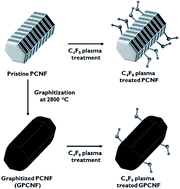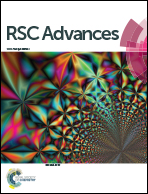Enhancement of the rate performance of plasma-treated platelet carbon nanofiber anodes in lithium-ion batteries†
Abstract
The rate performances of lithium-ion battery (LIB) anodes using platelet carbon nanofiber (PCNF) and its graphitized version (GPCNF) are enormously enhanced by introducing carbon–fluorine (CmFn) functional groups on the nanofiber surfaces. The CmFn functional groups are selectively introduced through controlled plasma treatment in vacuo with C4F8 gas. Combined X-ray photoelectron spectroscopy (XPS), Fourier transform infrared spectroscopy (FT-IR) and time-of-flight secondary ion mass spectrometry (TOF-SIMS) analyses demonstrate that the CmFn functional groups had mainly semi-ionic C–F bonds, which are introduced only on the surface of PCNF and GPCNF. PCNF treated with the plasma for 60 s (PCNF–F60 s) exhibits the largest discharge capacity of 387 mA h g−1 with increased first-cycle coulombic efficiency and a discharge capacity of 293 mA h g−1 at the 10C rate. These are 1.13- and 1.63-fold higher, respectively, than those of pristine PCNF. The presence of CmFn functional groups on the PCNF and GPCNF surfaces can reduce the resistance of the anode, which is related to lithium-ion migration and charge transfer resistance. The improved migration and reduced resistance result in a marked increase in rate performance at discharge without deterioration of the first-cycle coulombic efficiency.


 Please wait while we load your content...
Please wait while we load your content...